The 10-Minute Rule for Snake Plant Leaves Turning Yellow
Snake Plant Leaves Turning Yellow for Dummies
Table of ContentsThe Buzz on Snake Plant Leaves Turning YellowSee This Report about Snake Plant Leaves Turning YellowOur Snake Plant Leaves Turning Yellow PDFsThe Single Strategy To Use For Snake Plant Leaves Turning YellowThe Basic Principles Of Snake Plant Leaves Turning Yellow
Right here are seven reasons your serpent plant's leaves can be turning yellow and exactly how to repair it. A number of different plant problems can trigger yellow fallen leaves, or chlorosis. Chlorosis happens when plants don't have the micronutrients they require to produce chlorophyll, that makes foliage eco-friendly and allows plants to convert sunshine into food.Snake plants are drought forgiving many thanks to their succulent leaves. These plants grow finest in loose, well-drained soil that's enabled to dry totally between waterings and may just require water when per month throughout winter months. Overwatering can protect against origins from soaking up moisture and nutrients that the plant requires and can also create origin rot.
A potbound plant can't take in nutrients from the dirt. If your serpent plant is overcrowded or outgrowing its pot, this might be the reason of yellow fallen leaves. A periodic yellow leaf is totally regular for a serpent plant. As the plant ages, old leaves yellow, die, and hand over as they're replaced with brand-new ones.
Make certain the plant has intense, indirect light and constantly cozy temperatures, and water only when the dirt has completely dried. Keep an eye out for problems and capture them at an early stage to maintain your plant looking healthy and balanced and gorgeous.
See This Report about Snake Plant Leaves Turning Yellow
If the fallen leaves on your serpent plant are getting soft, it's typically an indicator of also much water. Snake plants store water in their leaves and if they're overwatered, the leaves can end up being soft and mushy. If you think your serpent plant is being overwatered, enable the soil to dry out totally prior to watering again.
Yes, some yellowing is typical and to be expected on older fallen leaves, especially as snake plants age. If the plant is otherwise healthy and balanced and the leaves are just lightly yellowed then there is no reason for problem. Nevertheless, if the fallen leaves are dramatically yellowed or if there are various other indicators of distress after that it's ideal to do something about it.
Dead leaves can provide a home for insects and illness, which can after that infect the remainder of the plant. To get rid of a dead fallen leave, merely suffice off at the base with a sharp blade or scissors. Be certain to sanitize your cutting tool in between cuts to avoid the spread of disease.
In basic, snake plants ought to be sprinkled every one to 2 weeks. If you assume your serpent plant has been overwatered, the first step is to quit sprinkling it.
The Only Guide for Snake Plant Leaves Turning Yellow
With a little examination, you must have the ability to determine the cause and take actions to repair the trouble and have a healthy and balanced snake plant.
The serpent plant continue reading this is a trendy houseplant. The snake plant is one of those plants that are excellent for growing indoors in a terrarium, Serpent plants can grow quite big, however they additionally tend to be pretty low-maintenance. That doesn't imply you should not pay focus to their appearance. Expect your near the bottom due to a lack of nutrients or other issues.
When the soil is overwatered, the plant cells take in more water than they can keep. Drooping serpent plant fallen leaves are triggered by soaked-up leaf cells shedding their firmness.
It is, consequently, more probable that your plant will detect yellow spots on its leaves if you overfeed it with fertilizer during winter. The leaves of serpent plants are additionally vulnerable to yellowing when overfed, particularly if the roots are vulnerable. Repotting your yellowing, sprinkling just when the dirt dries, and offering optimum temperature and light conditions can save it.
All About Snake Plant Leaves Turning Yellow

Your can be removed by cutting off the yellow Learn More Here suggestions. The trimmed fallen leaves must grow longer if they are watered appropriately and have optimum light and temperature level conditions. Click Here It is very important to keep in mind that the sharp suggestions will not grow back, causing them to attract attention from the remainder of the leaves.
At the same time, you can remove damaged leaves from the base of the plant. The crucial message is to allow the snake plant time to recuperate.

The Facts About Snake Plant Leaves Turning Yellow Uncovered
A few of one of the most typical causes are provided below (Snake Plant Leaves Turning Yellow). Sansevierias like completely dry climates and choose little water maintained at a gap of one or two times once a week in summer season and regular monthly in winter months. But when the water dosage leaves control, your Sansevieria will deal with overwatering. One of the most typical problem released by overwatering is root rot leading to mushy roots and stems with a foul scent.